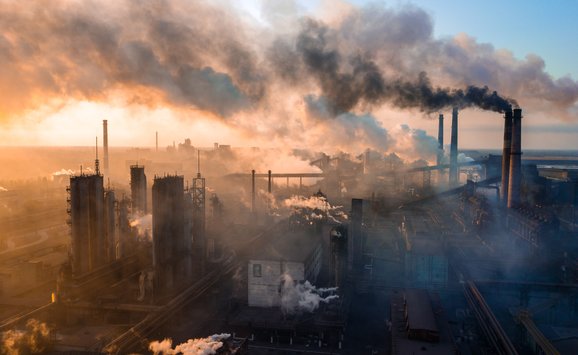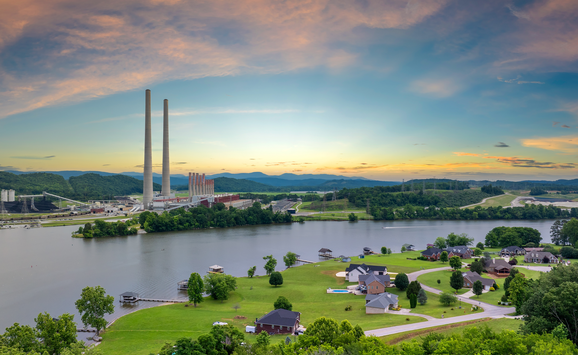THE PROTECTION of visibility is playing a greater role in the pattern and scale of development of Southwestern coal resources than any other environmental factor, including other aspects of air pollution. Water is scarce, of course, but because of the opportunities for reducing water use, obtaining it from unusual sources like wells thousands of feet deep, and by diverting it from agriculture, even large energy development would not be much hindered by lack of it.
There are two main reasons why visibility takes on such a major role. First, the air in the Southwest is in general still of high quality, and it is dry—in contrast to much of the country where the atmosphere close to the earth is hazy most of the time anyway because of moisture and natural and man-made contaminants. Consequently, one can see long distances with great clarity. These vistas and associated brilliance of color are a main feature of the attractiveness of the Southwest. In the East, twenty miles of visibility would be considered excellent. In the West, twenty miles of visibility would obscure almost the entire landscape. Thus, what might be regarded as a very small concentration of a contaminant in the East has an important deteriorating effect on the distance and quality of visibility in the Southwest.
Second, the Southwest is studded with national parks and monuments, wilderness areas, and Indian reservations, all of which were accorded a special status under the 1977 Clean Air Act Amendments. This point needs to be considered in the context of how national law attempts to control emissions from power plants and other stationary sources of pollutants.

Legal requirements. National labs place two types of restrictions on the discharge of pollutants into the atmosphere: (1) emissions regulations, and (2) ambient standards. Emissions regulations prescribe the allowable emissions rate from a source: For example, a power plant may emit some number of pounds of sulfur dioxide for each 1 million Btus of heat input. Examples of emissions regulations are the Federal New Source Performance Standards. States also have standards for new sources which in many, but not all, cases are equal to the federal standards. Under federal law, states are also required to establish compliance plans pertaining to existing sources.
Ambient standards specify the allowable concentrations of pollutants in the air itself. The major goal of the Federal Clean Air Act is to achieve ambient air standards and to limit deterioration of air quality in areas where the quality exceeds the standards. Related to the ambient standards are "nondeterioration increments." These are permissible increases in air pollution that are associated with new industrial sources.
Under present interpretation of the law, a geographic area may be classified Class I (very little deterioration allowed), II (moderate deterioration allowed), or III (significant deterioration allowed so long as ambient standards are not violated). Areas are initially designated Class II, except for areas specified as Class I in the legislation. Class-I areas are places such as national parks and wilderness areas. Indian tribes may also designate their reservations as Class I. These are areas where small changes in air quality may be detrimental and where industrial facilities are presumed to be inconsistent with current land use. The 1977 Amendments to the Clean Air Act for the first time established, as a national goal, protection of visibility in designated Class-I areas.
The spillover of pollution from a new source to nearby areas must also be considered. For example, the source may be in an area classified in one category, but the air may be degraded in an area classified in another way. Thus, if a plant were located on the Kaiparo-Wits Plateau, which was designated Class II, it would in principle not be permitted to produce concentrations beyond those permissible at Bryce Canyon, which is Class I and which would receive significant pollution from Kaiparowits.
For any new source, the effective criterion is whether a computer model of the distribution through space of the emissions from the proposed source (called an air dispersion model) predicts a violation of the ambient standards or the nondeterioration increments.

A Case Study. Air dispersion modeling is at best a rather imprecise science, especially in the mountainous West. Taking account of other than flat terrain greatly complicates air dispersion models, but predictions which do not consider high terrain may be greatly in error. Recent experiments have shown that flat-terrain models may dramatically underestimate actual concentrations. For this reason, the Southwest Region Under Stress Project—sponsored by Resources for the Future and the University of New Mexico—developed a high-terrain dispersion model to analyze regulatory alternatives. This model forecasts the distribution through space of emitted pollutants like sulfur oxides (SO2) and oxides of nitrogen (NO2) and calculates visibility effects at various distances from the source or sources.
To get a reading of what the visibility provisions of the Clean Air Act, if strictly interpreted and successfully enforced, might mean to the nature of southwestern development, the project performed several case studies. One of these was of possible development in the Kaiparowits Plateau of Southern Utah.
Southern California Edison had proposed several years ago that a very large, 3,000-megawatt (MW) coal-fired power plant be built near Glen Canyon National Recreation area northwest of Page, Arizona. Concern was expressed that the Kaiparowits plume would combine with the plume from the existing Navajo plant and produce excessive concentrations of pollutants on high terrain. For this reason, Secretary of Interior Morton rejected an application for a permit to provide federal water and land to this plan.
Southern California Edison reapplied, this time choosing a new site which was free of some of the difficulties of the earlier site. The new site met opposition on the grounds that the plant would impair air quality in Glen Canyon National Recreation area, Bryce Canyon National Park, Capitol Reef National Park, and, possibly, Grand Canyon National Park. Values in excess of Class-I increments for sulfur oxides and possible visibility impairment (though no model was then available to test this) were cited as evidence of air quality effects. Eventually Southern California Edison withdrew its permit request, later suggesting that a coal-gasification plant be constructed at the same site.
In this case study, completed in 1978, both options—a 3,000 MW coal-fired power plant and a high-Btu synthetic gas plant—were considered. The modeling results suggested that Class-II (the classification for the Kaiparowits Plateau) increments for sulfur oxides would be met, but that particulate levels might approach or even exceed Class-II increments on high terrain, much of which is now designated Class I. In the latter case a key concern is the nitrates produced in the plume through chemical reactions with the atmosphere. Nitrogen dioxide and fly ash would reduce visability in the national park areas from 160 kilometers(km) down to 24-60 km. The plume would have a marked brownish appearance against a blue sky. Clearly, the type of plant contemplated at Kaiparowits would not be permissible under present law because of its effects on visibility.
For the gasification plant, the effects would be considerably less. In Bryce Canyon National Park the visible ranges would be reduced only from 160 km to 130-154 km during stable light-winds conditions. Thus the impacts would be much less than those from the power plant. Class-I increments would still be exceeded, but it appears that design changes in the plant could eliminate this relatively small violation.

Implications. The Southwest Region Under Stress team did case studies of other major coal resource areas in the region including the San Juan Basin and the proposed Price—Green River Power corridor. The results confirm those of Kaiparowits. It will be extremely difficult, if not impossible, to locate large new power plants in the region without violating the Class-I visibility requirements contained in the present law. Thus, if coal development proceeds on a large scale, it will likely take other forms than the massive electric-generating plant construction previously contemplated. It will take the form of smaller plants on the periphery of the region, of conversion to other fuels such as gas, or of simply transporting the coal to power plants closer to the load centers.





